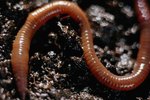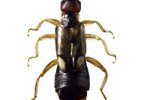
Although you probably wouldn't mistake a centipede for an earthworm, there are some similarities between these two very different creatures. Many types of both species prefer living in moist areas, although worms live under the ground and centipedes above it. Each is beneficial in its own way. Worms improve soil quality, while centipedes help eradicate certain insect pests.
Legs Or No Legs
Centipede literally means "100 legs," but the number of legs possessed by a particular species ranges in number from 15 to 177 pairs, or 30 and 354 individual legs. Each segment of a centipede's body contain a pair of legs. Legless earthworms are annelids, meaning "little rings." Their bodies contain between 100 and 150 ring-like segments, each of which has bristles and muscles, which allow the worm to move.
Color and Length
Earthworms and centipedes can appear in similar shades. Most centipedes are brown, ranging from a reddish-brown shade to dark brown. Earthworm tones also run the brown gamut, from red wigglers to deep chocolate hues. Depending on the species, centipedes and earthworms can grow to the same length. The largest centipedes might reach 6 inches or more, although most worms and centipedes are considerably smaller.
Creating New Creatures
While centipedes are either male or female, earthworms are hermaphrodites, containing the sex organs of both genders. These organs produce eggs and sperm, but the earthworm does need another earthworm for reproduction. Mating occurs when two worms exchange sperm to fertilize the eggs in their bodies. Fertilized eggs pass through a slimy tube, forming cocoons. They are deposited into the earth, eventually hatching into worms. In contrast, centipedes actually go through a kind of courtship. Some male centipedes species weave a pad filled with sperm. He then performs a courtship dance to alert a female. During the dance, the male bumps the female's back legs with his antennae. While some species lay eggs, others give birth to young.
Eating Habits
Earthworms consume bacteria, fungi and protozoa, while centipedes eat other insects and worms. Centipedes sport strong fangs with which they grab prey. They then inject venom into the victim. Centipedes can bite people, although these bites are generally harmless unless the individual happens to be allergic to the venom.
Life Span
One commonality between earthworms and centipedes is a relatively long life span for such tiny animals. While either might get devoured by predators or destroyed by humans, earthworms or centipedes escaping such mishaps might reach the age of 5 or 6.
References
- Orkin: Centipedes
- Texas A&M AgriLife Extension: Centipede, Millipede
- United State Department of Agriculture: The Living Soil -- Earthworms
- Colorado State University Extension: Earthworms
- Orkin: Centipedes' Reproductive Cycle
- City of Euless, Texas: Worm Reproduction and Development
- University of Pennsylvania: Earthworms
Photo Credits
-
Ryan McVay/Photodisc/Getty Images
Writer Bio
Jane Meggitt has been a writer for more than 20 years. In addition to reporting for a major newspaper chain, she has been published in "Horse News," "Suburban Classic," "Hoof Beats," "Equine Journal" and other publications. She has a Bachelor of Arts in English from New York University and an Associate of Arts from the American Academy of Dramatics Arts, New York City.



